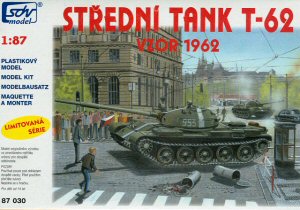
SDV 1/87 T-62 Medium Tank Model 1962 Kit First Look
By Cookie Sewell
| Date of Review | December 2006 | Manufacturer | SDV |
|---|---|---|---|
| Subject | T-62 Medium Tank Model 1962 | Scale | 1/87 |
| Kit Number | 87030 | Primary Media | 54 parts in olive green styrene |
| Pros | Clean, all styrene kit of this vehicle; closer to scale than older US made plastic T-62 kits; will eventually cover other versions of the T-62 | Cons | Some of the same problems as other T-62 kits carried over to this model; turret is wrong for a Model 1962 |
| Skill Level | Basic | MSRP (USD) | Approx $11.42 |
First Look
By now many modelers know the story of the T-62: Marshal of the Soviet Union Chuykov blew his top when he heard that the British Centurion was going to mount a 105mm gun, thus larger than the 100mm one in the T-54 and T-55 tanks, and demanded that Soviet industry get a bigger gun out into the field at once. The solution from the Ural Railway Wagon Construction Factory at Nizhniy Tagil was to stretch a T-55 hull, modify the experimental 100mm D-54 gun to a 115mm smoothbore, and put the two items together with a new turret. The result, Object 166, was accepted for service as the T-62 tank at the end of 1961.
Later, during the production run of the T-62 tank, it was also produced in Czechoslovakia and North Korea. There are three basic versions; the Model 1962, with a smooth turret and no AA machine gun and a T-55 style engine deck and radiator installation; the Model 1967, with the same turret and a new engine and radiator deck; and the Model 1970, which added a ring mount and DshK machine gun for the loader. Just over 20,000 T-62 tanks were built between 1962 and 1989.
SDV has now created a new kit of the T-62, which is more accurate in terms of scale with the old Armortec/Petner Panzers/Boley kit. It is based, as was the real one, on the late model T-55 chassis produced by SDV and uses many of the parts from those kits.
The model assembles in the same way as the T-55s – hull pan, fenders and upper hull sides, tracks and separate outer wheels. To this are added a turret decking with bulged sides, an engine deck, and a radiator deck based on the specific model of tank. The rest of the parts are the usual details – lights, fuel and oil tanks, ZIP (spare parts) bins, and the like.
The turret has the same shape problems as all other plastic T-62 kits, namely a straight front edge with no roll-under as seen on actual cast T-62 turrets. Due to the thin moldings, this may be hard to correct but with some careful filing and painting the general shape can be modified to more accurately represent the T-62's turret.
However, the kit comes with the hatch for the Model 1970 and not the Model 1962. To accurately replicate the Model 1962 the hatch will have to be sanded off and a new hatch, slightly domed, scratchbuilt for it with front-mounted hinges.
The directions are in Czech and with some German, as is a small historical booklet about the use of the T-62 during the "Prague Summer" of 1968 and the Soviet invasion in August of that year. Photos of T-62s and Czech citizens are included in the booklet, but alas, as it is not in English it loses something in the translation!
Seven finishing options and a nice set of decals by MPD are provided with the kit: Soviet Army, Czech Invasion August 1968; Soviet occupying forces in Czechoslovakia, 1972; Egyptian Army, 1973; Syrian Army, Lebanon 1982; Iraqi Army, 1991; Northern Alliance, Afghanistan, 2001; and Soviet-built T-62 in Czech service, 1999. Markings for specific vehicles are included, with those of the Iraqis being recognizable as tank 33B, 3rd Regiment, 6th Armored Brigade, 3rd "Saladin" Armored Division, 1991. (Note that this tank will have to have a yellow bore evacuator with a white band in the center.) Also included are extra markings for East Germany.
Overall, while not quite spot on for a Model 1962, this kit is better in most respects to both the Armortec and even the 1/35 scale Tamiya kits, and is a good choice for wargamers and good start for small-scale modelers to make an accurate T-62.
Thanks to Jan Podubecky for the review sample.







